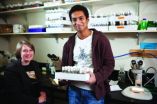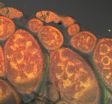(Press-News.org) Researchers from CSIC's Aula Dei Experimental Station in Zaragoza, Spain have confirmed that the frequency of intense rainfall has been decreasing in the Ebro basin since 1955.
Despite what it may seem, intense rain is becoming rarer in the Ebro basin according to two studies carried out by Spanish researchers from the Department of Soil and Water of CSIC's Aula Dei Experimental Station in Zaragoza. Their results have been published in the 'Journal of Hydrology' and the 'Hydrology and Earth System Sciences' journal.
Santiago Beguería, one of the authors of both studies, explained to SINC that here we are not dealing with torrential rainfall like recent deluges that have caused great increases in the Ebro: "These are extraordinary events and their sporadic and elusive nature makes it difficult to make concrete conclusions. They are therefore harder to study."
In fact, according to a third study published in 2011 in the 'International Journal of Climatology', in which Beguería also participated, "we cannot say in general terms that there is an annual trend in one sense or another for the maximum intensity of these extreme precipitations," outlines the author himself.
There is the hypothesis that more violent and frequent rains are caused due to climate change, which are then followed by more intense droughts. Many studies state that this effect can already be seen in the weather of recent decades.
However, according to Beguería "this type of global affirmations has regional nuances."
More specifically, "different studies on the Iberian Peninsula show that the predicted increase of extreme rain is not actually occurring," ensures the expert.
Beguería's studies focus on the northeast of Spain and the researchers have reached the same conclusion after analysing rainfall erosivity (the capacity of a downpour to cause erosion) between 1955 and 2006.
VIDEO:
The studies focus on intense rainfall and not torrential downpours, like those that have recently affected the River Ebro
Click here for more information.
For this purpose, use was made of an erosivity database developed from records belonging to the Spanish Meteorological Agency (AEMAT) and the Ebro Hydrographic Confederation and a generalised decrease in this parameter was observed both on an annual and season level.
This tendency can be explained by the decrease in the amount of intense rain.
"This is a significant finding since it could be indicative of persistent long-term climate changes that have a regional effect," outlines Beguería.
The author clarifies that his work focuses on identifying these tendencies but states that it is difficult to "explain their causes given that climate is a chaotic system." Furthermore, he states that whereas for some phenomena, such as global warming, there is a high consensus regarding the causes, this is not the case for many other variables."
"As we do not know the causes, we are in no position to predict whether these tendencies will continue in the future. It is very difficult to link tendencies as we have seen with more general patterns, such as global warming. It may be possible that what we have found is a consequence of natural climate variability," explains the researcher.
"However, given the significant consequences of such a change on the frequency and magnitude of rainfall, our study proves the need to continue researching this phenomenon," concludes the expert.
INFORMATION:
Reference:
Marta Angulo-Martínez, Santiago Beguería. "Do atmospheric teleconnection patterns influence rainfall erosivity? A studyof NAO, MO and WeMO in NE Spain, 1955" Journal of Hydrology 450 (2012) 168. doi: 10.1016/j.jhydrol.2012.04.063
M. Angulo-Martínez, S. Beguería. "Trends in rainfall erosivity in NE Spain at annual, seasonaland daily scales, 1955" Hydrol. Earth Syst. Sci., 16, 3551, octubre 2012. doi: 10.5194/hess-16-3551-2012
Santiago Beguería, Marta Angulo-Martínez, Sergio M. Vicente-Serrano, J. Ignacio López-Moreno, Ahmed El-Kenawy. "Assessing trends in extreme precipitation events intensityand magnitude using non-stationary peaks-over-thresholdanalysis: a case study in northeast Spain from 1930 to 2006" Int. J. Climatol. 31: 2102 (2011), doi: 10.1002/joc.2218
Intense rain in the Ebro basin is becoming more and more uncommon
2013-02-05
ELSE PRESS RELEASES FROM THIS DATE:
Social scientists propose integrated information systems for smarter health and social care
2013-02-05
A new ESF position paper calls for increasing use of ICT to deliver health and social care services.
A new position paper, Developing a New Understanding of Enabling Health and Wellbeing in Europe, published today by the European Science Foundation, highlights the need for change in health and social care across Europe.
As social care and informal care are essential to improving health and preventing health problems, especially in an ageing population, there are still large gaps of knowledge in how best to organise this, and how best to combine it with health care. ...
Newly discovered plant structure may lead to improved biofuel processing
2013-02-05
Athens, Ga. – When Li Tan approached his colleagues at the University of Georgia with some unusual data he had collected, they initially seemed convinced that his experiment had become contaminated; what he was seeing simply didn't make any sense.
Tan was examining some of the sugars, proteins and polymers that make up plant cell walls, which provide the structural support and protection that allow plants to grow. Yet his samples contained a mixture of sugars that should not be present in the same structure.
However, Tan was convinced that his samples were pure so ...
A spiral galaxy with a secret
2013-02-05
Despite its appearance, which looks much like countless other galaxies, Messier 106 hides a number of secrets. Thanks to this image, which combines data from Hubble with observations by amateur astronomers Robert Gendler and Jay GaBany, they are revealed as never before.
At its heart, as in most spiral galaxies, is a supermassive black hole, but this one is particularly active. Unlike the black hole at the centre of the Milky Way, which pulls in wisps of gas only occasionally, Messier 106's black hole is actively gobbling up material. As the gas spirals towards the black ...
Kaiser Permanente's anti-obesity interventions in schools show signs of success
2013-02-05
OAKLAND, Calif., February 5, 2013 – Community-based efforts to change the environment are proving to be an effective way of encouraging more physical activity and nutrition among school-age children, according to findings announced today from Kaiser Permanente. Researchers examined a series of Kaiser Permanente community-based obesity prevention interventions in adults and children and found that the more effective obesity prevention interventions were those that were "high dose" – reaching large populations with greater strength – and those that focused specifically on ...
21 minutes to marital satisfaction
2013-02-05
EVANSTON, Ill. --- Marital satisfaction -- so critical to health and happiness – generally declines over time. A brief writing intervention that helps spouses adopt a more objective outlook on marital conflict could be the answer.
New Northwestern University research shows that this writing intervention, implemented through just three, seven-minute writing exercises administered online, prevents couples from losing that loving feeling.
"I don't want it to sound like magic, but you can get pretty impressive results with minimal intervention," said Eli Finkel, lead author ...
Achilles heel: Popular drug-carrying nanoparticles get trapped in bloodstream
2013-02-05
ANN ARBOR—Many medically minded researchers are in hot pursuit of designs that will allow drug-carrying nanoparticles to navigate tissues and the interiors of cells, but University of Michigan engineers have discovered that these particles have another hurdle to overcome: escaping the bloodstream.
Drug delivery systems promise precision targeting of diseased tissue, meaning that medicines could be more effective at lower doses and with fewer side effects. Such an approach could treat plaques in arteries, which can lead to heart attacks or strokes.
Drug carriers would ...
Biologists map rare case of fitness-reducing interaction in nuclear, mitochondrial DNA
2013-02-05
BLOOMINGTON, Ind. -- A team of biologists from Indiana University and Brown University believes it has discovered the mechanism by which interacting mutations in mitochondrial and nuclear DNA produce an incompatible genotype that reduces reproductive fitness and delays development in fruit flies.
The new research, led by IU biologists Kristi Montooth and Colin Meiklejohn and including former IU undergraduate researcher Mo Siddiq, describes the cause and consequences of an interaction between the two genomes that co-exist within eukaryotic cells. Animal mitochondrial ...
EARTH: Moon could have formed from Earth after all
2013-02-05
Alexandria, VA –Scientists are revisiting the age-old question of how Earth's moon formed with the development of two new models that work out the complicated physics of planetary collisions. The idea of a moon-forming collision is not new: The Giant Impact Theory put forth in the 1970s suggested that the moon resulted from a collision with a protoplanet approximately half the size of ancient Earth. But the physics underlying such a collision implied that the moon should be made up of debris mostly from the protoplanet. Since then we've discovered the moon is instead very ...
Mitochondrial mutations: When the cell's 2 genomes collide
2013-02-05
PROVIDENCE, R.I. [Brown University] — Diseases from a mutation in one genome are complicated enough, but some illnesses arise from errant interactions between two genomes: the DNA in the nucleus and in the mitochondria. Scientists want to know more about how such genomic disconnects cause disease. In a step in that direction, scientists at Brown University and Indiana University have traced one such incompatibility in fruit flies down to the level of individual nucleotide mutations and describe how the genetic double whammy makes the flies sick.
"This has relevance to ...
Old age offers no protection from obesity's death grip
2013-02-05
Obesity kills, giving rise to a host of fatal diseases. This much is well known. But when it comes to seniors, a slew of prominent research has reported an "obesity paradox" that says, at age 65 and older, having an elevated BMI won't shorten your lifespan, and may even extend it. A new study takes another look at the numbers, finding the earlier research flawed. The paradox was a mirage: As obese Americans grow older, in fact, their risk of death climbs.
Ryan Masters, PhD, and Bruce Link, PhD, at Columbia University's Mailman School of Public Health, in collaboration ...



